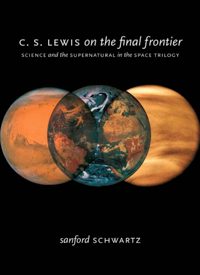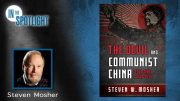
A generation ago, Lewis’ nonfiction works such as Mere Christianity and Surprised by Joy were of primary significance for those individuals engaged in substantive reflection on his thought. Nevertheless, the fictional works that gave expression to Lewis’ worldview never lagged far behind in sales and readership. In fact, today Lewis’ apologetic writings have been eclipsed in the public spotlight by his works of fiction, even as he remains prominent among in the ranks of the 20th century Christian apologists.
The release of three movies (The Lion, the Witch and the Wardrobe [2005], Prince Caspian [2008], and The Voyage of the Dawntreader [2010]) based on adaptations of books from Lewis‘ Narnia series has focused popular attention on the seven books of that series, particularly since the books were written primarily for a younger audience and provide further grist for a movie market thriving on adaptations of the Harry Potter books and other magical or fantastical works.
Lewis’ “Space Trilogy” — Out of the Silent Planet (1938), Perelandra (1943) and That Hideous Strength (1945) — was written for a more mature audience than that which is addressed in the Narnia tales, but these books have rarely received the scholarly attention they so richly deserve. Schwartz’s book, C. S. Lewis on the Final Frontier: Science and the Supernatural in the Space Trilogy, offers a worthy correction to this deficit. Schwartz provides careful attention to the internal structure of each book, but even more importantly, he relates the development of Lewis’ thought to his study of science and philosophy — both ancient and modern — and the implications of modern currents in human thought for the spiritual future of our species.
Schwartz’s study is based on three premises: First, a shared “internal configuration” to all three works, second, “significant changes in the representation of the modern evolutionary model as the series proceeds,” and, third, Lewis’ Augustinian view that “bad things are good things perverted.” The significance of these premises, which Schwartz proceeds to demonstrate with sufficient scholarship, is quite significant to understanding the entirety of the “Space Trilogy.” In Schwartz’s words:
Taken together, these three working tenets suggest that the Space Trilogy, which began with no evident master plan and developed gradually over a period of years, is [a] more integrated and systematically organized series than is generally assumed. More important, they indicate that contrary to Lewis’s self-styled image as an intellectual “dinosaur” stranded in the modern world …, the Space Trilogy and its author are at once deeply engaged with the modern intellectual revolution and eager to explore some of the pioneering insights that arose in its wake.
Schwartz’s assessment is correct; in fact, The Hideous Strength — in particular — is a distillation of many of Lewis’ central criticisms of the errors of Modernity. The medium of fiction provides the opportunity for a clarity and brevity of expressions of truth that are not as easily attained in the realm of nonfiction. The novel need not “prove” anything; the author simply sets forth evident truth and permits it to “speak for itself.”
As Schwartz observes, the three novels also provided Lewis with the opportunity to offer a corrective to certain literary imagery that developed during the Renaissance. In the second novel, Perelandra, the planet Venus becomes the setting for what is, in part, Lewis’ reconceptualization of Milton’s Paradise Lost. While Milton appears somewhat entranced by his heroic conceptualization of the Devil, Lewis’ Augustinian understanding offers a corrective to Milton:
Invoking the Augustinian notion that evil has no substantial existence and should be regarded merely as a defection from the good, Lewis shows that Milton’s fallen archangel should be regarded not as an authentic hero but as a warped imitation of his Creator. The same logic, which presupposes that God “has no opposite” …, may account for the otherwise baffling situation in Perelandra, where Lewis presents creative evolution as a dangerous distortion of the divinely ordained and beneficent temporal dynamism of his own imaginary paradise.
Lewis’ Augustinian viewpoint insulates him from gnostic dualism, but his partial capitulation to Modernism — his “beneficent temporal dynamism” — requires him to construct a somewhat rickety understanding of the created order, nonetheless. Schwartz maintains that by “adopting Augustine’s ‘privative’ notion of evil as nothing other than the distortion of the Good, Lewis turns the apparent antithesis between Christianity and the post-Darwin currents of modern thought into a relationship between a transcendent original and its parodic imitation.” In truth, one suspects that although Schwartz is certainly correct with regard to Lewis’ intention, his effectiveness in this endeavor is far from convincing.
Schwartz’s identification of Lewis’ “updated form of Christian Neoplatonism” also complicates Lewis’ worldview; such “Christian Neoplatonism” is present in all three volumes, but most markedly so in the last book of the trilogy. In fact, the efforts to reconcile Neoplatonism to Christian Orthodoxy have consistently failed since they were first undertaken in the 15th century by Marsilio Ficino (1433–1499) and Giovanni Pico della Mirandola (1463–1494). Lewis’ “Space Trilogy” owes a certain intellectual debt to the Hermetic Reformation undertaken by the Neoplatonic theologians in Florence at the beginning of the Modern Age.
Schwartz’s book offers a worthy assessment of three significant novels from one the most important Christian apologists of the 20th century. Any admirer of the thought of C.S. Lewis will greatly profit from a close study of Schwartz’s analysis.
Sanford Schwartz, C. S. Lewis on the Final Frontier — Science and the Supernatural in the Space Trilogy, (Oxford: Oxford University Press, 2009). 240 pages. hardcover. $27.95



